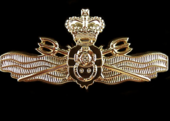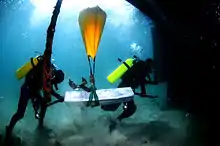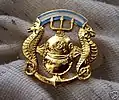List of military diving units
This is a list of notable military diving units and may contain combat units, salvage units, training units and diving research units which are present or past commands of any branch of the armed forces of any country.
Argentina
- Tactical Divers Group (Buzos Tácticos) is the special operations unit of the Argentine navy. The operatives are combat divers, EOD/demolition technicians, and parachutists.
Austria
- The Jagdkommando (German for Hunter force) is the Austrian Armed Forces' Special Operations group.
Australia

- Clearance Diving Branch is the specialist diving unit of the Royal Australian Navy whose versatile role covers all spheres of military diving
- Special Air Service Regiment is a dedicated special forces unit of the Australian Army that includes undertaking water operations with the emphasis of insertion onto land
Bangladesh
- 1st Para-commando Battalion of Bangladesh Army has frogman commando unit specialized for underwater demolition trained under supervision on Bangladeshi Naval special forces SWADS
Belgium
- Special Forces Group has a specialized diving company for education and training of combat swimmers.
Brazil
- Brazilian Commando Frogmen (GRUMEC) is a combat diver group
Brunei
- Naval Surface Action Group[1]
Canada
- Canadian Armed Forces Divers
Croatia
- Croatian Special Operations Battalion (BSD)
Denmark
- Danish Frogman Corps (Danish: Frømandskorpset) is an elite special forces frogman corps in the Royal Danish Navy
Eritrea
- During Eritrea's war of independence against Ethiopia, the rebel forces had a combat frogman force. After the war, some of those frogmen were retrained as dive guides for the scuba diving tourism trade.
Finland

Finnish diver insignia
- The Finnish Navy has trained Finnish combat divers since 1954. Conscripts and career military are eligible to apply for the training. Annually, about 20 conscripts are trained for diving duties. Applying for combat diver training is voluntary, and the selection criteria are stringent.[2] The conscript divers are trained either for anti-mine or for commando operations, while career personnel may also be trained for deep-sea diving duty.[3] All conscript divers receive at least NCO training during their 12-month service period.
France
- Commandos Marine, the special operations forces of the French Navy
- FORFUSCO, Force maritime des fusiliers marins et commandos, the section of the French Navy that includes Commandos Marine
- Commando Hubert, the combat diver unit belonging to Commandos Marine
- History of French commando frogmen
Germany
- Kommando Spezialkräfte Marine – Commando amphibious warfare force, called the Kampfschwimmer ("Combat Swimmers", abbreviated "KSM").
- Minentaucher Mine clearance divers.
Greece
- Underwater Demolition Command
- 1953: first Amphibious Reconnaissance Squad is founded.
- 1957–1968: Underwater Demolition Training School operates in Kannelopoulos training center.
- 1968: Underwater Demolition Team Division established in Skaramanga.
- 1969: UDT Division renamed to Underwater Demolition Unit.
- 2002: Underwater Demolition Unit renamed to Underwater Demolition Command.[4]
India
%252C_conducted_training_exercise_with_Indian_Para_Special_Forces_(3).jpg.webp)
Green berets and PARA SF training together.
- MARCOS – The MCU is the elite naval special operations unit of the Indian Navy that undertakes Amphibious reconnaissance, Amphibious warfare, underwater demolition.
- Para (Special Forces) - Some commandos of the elite Parachute Regiment (India) special forces of the Indian Army are trained combat divers.
- NSG (National security guards) - operatives of Special action group of NSG are from the special forces of the Indian armed forces on deputation, some commandos of the unit are combat diving qualified.
Indonesia
- KOPASKA is the main underwater combat, Frogman, Special forces unit of the Indonesian Navy.
Ireland
- Naval Service Diving Section (NSDS)
- Army Ranger Wing (ARW) Combat Diving Section
Israel

Israeli frogmen transfer equipment using lifting-bags
- Shayetet 13 is the elite naval commando frogmen unit of the Israeli Navy. The unit is considered one of the primary Special Forces units of the Israel Defense Forces and is one of the most secretive. The details of many missions and identities of active operatives are highly classified.
Japan
- Western Army Infantry Regiment (WAIR)
- Special Boarding Unit (SBU)
Lebanon
- Lebanese Navy SEALs Regiment
Malaysia
- PASKAL – Naval Special Forces of Malaysian Armed Forces.
- Naval Diving and Mine Warfare Headquarters – New Command for the elite Royal Malaysian Navy (RMN) divers. The same task once belongs to KD Duyong which now functioning as full-time diving school.[5]
- Grup Gerak Khas (GGK) – Malaysian Army Special Forces, there is Combat Swimmer Course as an advance training option for the members of GGK.
- VAT 69 Combat Divers Unit – A paramilitary special forces attached to the Royal Malaysian Police (RMP). There is a unit of combat divers in VAT 69.[6]
- UNGERIN – A paramilitary special operation forces attached to the Marine Operations Force of the RMP. Once known as RMP Combat Divers Unit (Malay: Unit Selam Tempur PDRM) before changing to current name in 2008. Few of the divers are absorbed from VAT 69 Combat Divers Unit.[7]
Mexico
Netherlands
- Korps Commandotroepen (KCT), (Riverine Operations Teams (OWG)), special forces of the Royal Netherlands Army.[8]
- Netherlands Maritime Special Operations Forces (NLMARSOF) (Special Forces Underwater Operators), special forces of the Royal Netherlands Marine Corps.
- Constructieduikerspeloton is the Army Engineers unit specialized in supporting Rivier Crossing Operations and executing heavy underwater construction operations. They are incorporated in 105 bridging company.
- Engineer combat divers of 11 airmobile engineer company. Operations include reconnaissance, demolition, and other.
- Beach Recce Teams of Surface Assault and Training Group of the Royal Netherlands Marine Corps.
- Defensie Duikgroep (Defense Diving Group) of the Royal Netherlands Navy. Organized into the Very-Shallow-Water-Diveteam (Supports amphibious operations of the Royal Netherlands Marine Corps by clearing beaches), the Deep Diving Team (Specializes in deep diving, clearing mines, rescues of crews of submerged submarines), and the Salvage & Construction team (Specializes in subsurface repair of ships, underwater construction, and harbor inspection).[9]
- Explosieven Opruimingsdienst Defensie (EODD) (Explosive Ordnance Disposal Service Defense). All members of the Maritime Company must be Clearance Diver trained before being allowed to serve in the EODD.[10]
New Zealand
- Navy Clearance Diving Group (CDG) formally known as the Operational Diving Team (ODT) is a clearance diving unit. Its focus is on Mine Countermeasures, amphibious Operations & Maritime explosive ordnance disposal. The CDG is ranked as one of the world's top clearance diving units. Military Dive Training support is supplied to Fiji, Tonga, and Samoa.[11]
- The New Zealand Special Air Service also has divers in its amphibious troops (the NZSAS has two Sabre Squadrons), with particular emphasis on insertion.
Norway
- Norway's commando frogmen corps is called Marinejegerkommandoen, "Navy Seals command", which is something like the British SBS.
- Norway has a clearance diver group called Minedykkerkommandoen, "Norwegian Navy EOD Command"(military formation)|command]]".
Pakistan
- Army Special Service Group (SSG) has a "Moses Company" that is uniquely modeled on the United States Army Special Forces, they mainly operate on inland rivers and waterfield in the five rivers of Punjab, Pakistan.
- Navy Special Services Group (SSGN) is also uniquely modeled on United States Navy SEALs entirely and is assigned to unconventional warfare operations in the coastal regions. During war, it is assigned to Midget submarines as Diver propulsion vehicle. All other training is similar to the Army SSG with specific marine orientation provided at its headquarters.
Philippines
- Naval Special Operations Group
Poland
Three Polish military units train and deploy frogmen in military operations. Most known are:
- JW Formoza
- JW Grom water operations detachment
- JW Komandosów's frogmen company.
Polish frogmen SF uses e.g. R.C.H OXY-NG2, Aqua Lung Amphora closed-circuit apparatus.
Portugal
Russia
- Russian commando frogmen
- Special Operations Forces
- Diver Units in different SpetsNaz Brigades and Naval Infantry Separate Reconnaissance Battalions.[12]
Singapore
Sri Lanka
South Africa
Spain
Spain has been training combat divers and swimmers since 1967. Two units in the Spanish Navy currently operate under a Naval Special Warfare mandate:
- UOE (Special Operations Unit) – All aspects of maritime special operations at sea, on land, and by air.
- UEBC (Specialist Combat Diver Unit) – Mainly hydrographic surveys and underwater demolitions.
There are working plans to fuse the two units into a single "Naval Special Warfare Unit" (UGNE), while maintaining their functional distinctiveness.
Sweden
- Swedish Amphibious Corps:
- The Reconnaissance Platoon, also referred to colloquially as the Attack Divers (A-dyk). They conduct long-range reconnaissance missions behind enemy lines, sabotage, clearing beach obstacles, hydrographic surveys, and although combat is not their priority, they have a limited ability to conduct direct action missions such as ambushes. Between 6 and 10 are trained each year. The Reconnaissance Platoon is a commando unit, belonging to the amphibious battalion of the Swedish Amphibious Corps. They offer one of the hardest and most demanding training regimens in the Swedish armed forces.
- Navy EOD-divers (Röjdyk)
- Army divers (FArb-dykare) Underwater welding, obstacle clearance, underwater demolition and repairs. Belongs to the engineer troops.
- Pioneer divers (Pionjärdyk) of the amphibious battalion. Underwater obstacle clearance, repairs and EOD on land.
- Navy attack divers. (Flottan A-dyk) Underwater sabotage on enemy ships and harbours.
Taiwan
- Republic of China Marine Corps Command
- Republic of China Navy
- Underwater Demolition Team (U.D.T) was withdraw from the R.O.C Navy in 2005 and was adapted to the ROC Marines Corps Amphibious Reconnaissance and Patrol Group
- Republic of China Army General Headquarters
- Aviation and Special Forces Command
- 101st Reconnaissance Battalion (better known as Sea Dragon Frogman, has a company station in Kinmen, Matsu, 3 in Penghu, and other frontline islands)
- Aviation and Special Forces Command
Thailand
- Royal Thai Armed Forces
- 3rd Special Forces Regiment, King's Guard (Airborne)
- Royal Thai Navy Diver & EOD
- Royal Thai Navy SEALs
Turkey
- Underwater Offence (Turkish Armed Forces), also known as Su Altı Taaruz – Special operations Forces of the Turkish Navy
- Special Forces Command (Turkey), also known as Özel Kuvvetler Komutanlığı (OKK) – Turkish special forces group
United Kingdom
- Special Boat Service is the Navy Service special forces unit
- Royal Navy Northern and Southern Fleet Diving Groups and Fleet Diving Units 1, 2 and 3 are the clearance diving units
- Special Air Service is the Army special forces unit that undertakes water operations (emphasis of insertion onto land)
- Royal Engineers: the corps has had army divers for over 170 years. Training was held at Marchwood in Hampshire until moving to HMS Gunwharf in Portsmouth in the early 1980s. Now a combination of Royal Engineers and Royal Navy all train at a special diving school at Horsea Island in Hampshire. The roles of the Royal Engineer Divers are probably the most diverse of all including construction, demolition, reconnaissance, search, recovery and sewer searches.
United States
- United States military divers – Underwater divers employed by the US armed forces, including navy, army, marines, air force and coast guard
- Underwater Demolition Team – US Navy special operations group
- United States Navy SEALs – US Navy special operations force
- Explosive ordnance disposal (United States Navy) – US Navy personnel who render safe or detonate unexploded ordnance
- United States Marine Corps Force Reconnaissance
- Battalion Reconnaissance – Reconnaissance assets of Marine Air-Ground Task Force
- United States Marine Raider Regiment
- Underwater Construction Teams
See also
- Clearance diver – Navy diver specialist with explosives
- United States military divers – Underwater divers employed by the US armed forces, including navy, army, marines, air force and coast guard
References
- http://www.navy.mindef.gov.bn/Site%20Pages/Assets.aspx
- Finnish Navy: Sukeltajakurssi – valintakoelajit Retrieved 14 February 2007. In Finnish
- Finnish Navy: Sukeltajakurssi – tehtävä Retrieved 14 February 2007
- "Archived copy". Archived from the original on 2011-06-14. Retrieved 2013-10-05.CS1 maint: archived copy as title (link)
- "Panji-panji KD Duyong". Official Portal for Royal Malaysian Navy (in Malay).
- "VAT 69 terus latih dan mantapkan pasukan polis". Utusan Malaysia (in Malay). 2 September 2008.
- "UNGERIN Itu Apa?". VAT 69 Facebook Page (in Malay). 28 February 2013.
- KCT frogman units
- RNZN – Navy Dive School
- "Ryazan Higher Airborne Command school". 2 August 2015.
This article is issued from Wikipedia. The text is licensed under Creative Commons - Attribution - Sharealike. Additional terms may apply for the media files.

